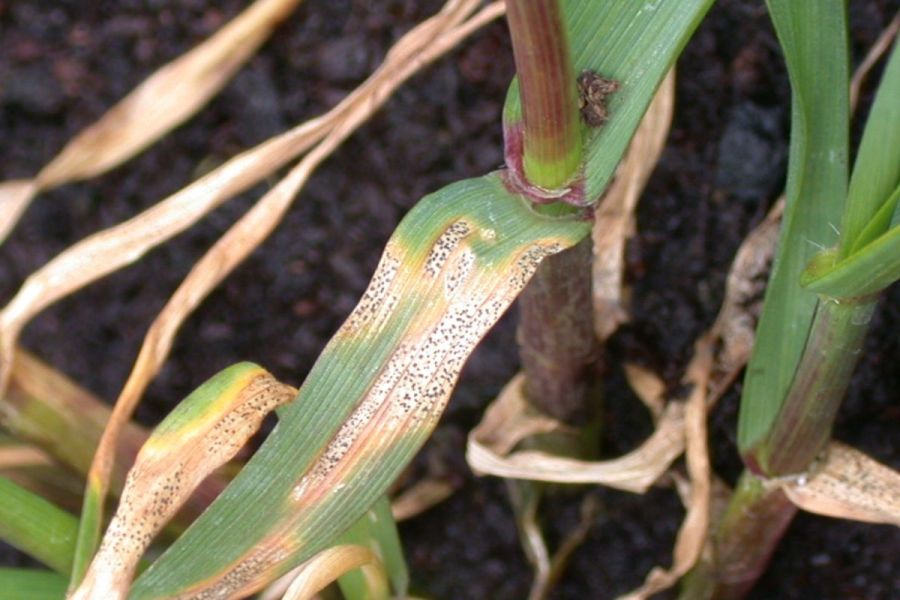With previous warnings of an impending ‘sea of septoria’, how are crops faring as the season continues? CPM joins the Bayer Crop Doctor team for an update on the sites and tips for next steps.
“The real risk is being premature with application timings due to an awareness of high disease pressure.”
By Janine Adamson
For many, a lack of spray days has continued to disrupt timely crop management and for those able to travel, it’s been a matter of prioritisation. Admittedly, Brits are renowned for commenting about the weather, but in this case, it really has thrown a spanner in the works for growers no matter where they’re located in the country.
With reports of missing T0s, coupled with the risk of sporulation rising, devising a robust plan for T1s is on the minds of the Bayer Crop Doctor team as they revisit sites in mid-April.
Callow, Herefordshire
Round two starts with a visit to Callow on 17 April. Whereas there was little to note between varieties during the last visit on 22 March, the team agrees the scenario has changed considerably. “Although you can see septoria across all varieties at some level, even Theodore and Champion, the level of infection varies depending on their ratings,” says ADAS’ Jonathan Blake.
“Crusoe looks especially dirty – 50-60% infection on leaf five. KWS Extase in comparison is around 5-6% on leaf six; RGT Wolverine is another dirty variety.”

At Great Tew, Jonathan Blake says there’s not one variety without some form of stem-based disease.
Herefordshire-based independent agronomist David Lines agrees with Jonathan’s sentiment that there’s been an ‘explosion of septoria’. “Temperatures have slowly started to increase and we’ve been experiencing milder daytimes, so it’s to be expected. Crops are waking up and growing away, that said, there’s been no opportunity to spray,” he says.
David explains that there’s been only one rain-free day in April so far, meaning many of his customers are still finishing T0s. Here at Callow, he confirms the plots are nowhere near ready for a T1 spray, with leaf three not yet emerged.
“For growers who’ve missed their T0s, they’ll want to consider increasing dose rates for T1 sprays. Multisite plus azole mixtures are a non-starter in the West, so it’ll have to be a dose of Ascra Xpro (bixafen+ fluopyram+ prothioconazole) at 1 l/ha,” says David.
He advises that cutting back isn’t an option. “I wouldn’t take the risk, you have to create a clean break from disease at T1 and then maybe make some cuts at T2, depending on the weather.”
Further inspection of the plots reveals a considerable amount of leaf yellowing, the source of which Jonathan questions. “I’m unsure it’s just septoria causing this,” he says.
Another stand-out disease across the varieties is eyespot, which Bayer’s Gareth Bubb highlights is a concern. “You wouldn’t expect this much eyespot given the mid-October drilling date. It doesn’t bode well for early drilled crops and second wheats,” he says.
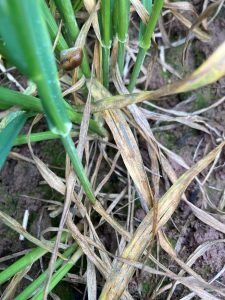
There’s been ‘an explosion of septoria’ across all varieties at all four sites, says the Crop Doctor team.
This is something Jonathan believes has been exacerbated by the wet weather. “You can see eyespot in KWS Extase (rated 4), KWS Palladium (rated 6) and Champion (rated 5), the latter doesn’t stand well either.” David concurs that eyespot is a problem he’s seeing across the board in commercial crops, even in first wheats.
He says this poses a considerable lodging risk and that, again, it’s not a time to scrimp. “Crops have been slow to take up nitrogen so there could be a sudden surge in growth, coupled with eyespot this potentially poses a risk. No one thanks you for a flat crop, it’s the first thing you spot,” he says.
Managing crop development is something David believes is improving among growers. “People learnt their lesson with Extase and now drill it later so it doesn’t romp as much. Another variety that’s cracking on this season is Palladium, especially the case for crops planted after potatoes,” he says.
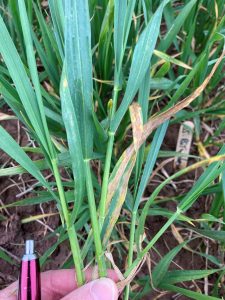
Wolverine is one of the varieties struggling with septoria pressure this season.
Looking forward, Gareth raises the question of what might happen if eyespot continues to be a problem. “In past seasons there’s been evidence of eyespot as far along as T2, it all depends on how much rain we have in April and May. It’s just so unpredictable at the moment, although milder temperatures are forecast, which could mean rust.”
To cover late eyespot, the team agrees on Ascra at T1 followed by Univoq (fenpicoxamid+ prothioconazole) at T2, although they highlight associated sprayer performance issues means some growers may approach this strategy with caution.
As per the previous visit, there’s no sign of either yellow or brown rust, despite everyone inspecting the vareties closely. Jonathan believes this is due to colder nights and ground frosts keeping it at bay.
Great Tew, Cotswolds
At Great Tew Estate on 18 April, it’s LG Skyscraper that immediately kicks off the commentary. Having shown initial signs of disease during the last visit on 22 March, Jonathan identifies it as having the highest septoria pressure of all varieties at the site.
“Skyscraper is rather grubby,” says Jonathan. “You can see the lower leaves are dying due to septoria infection. This is in comparison to Champion, which I’d say is the cleanest variety and reasonably green,” he says.
Overall, the team agrees that septoria pressure is in-line with AHDB Recommended List ratings, although Jonathan does have concerns. “Even with Champion’s septoria rating of 8.1, I wouldn’t be complacent,” he says.
Moving through the crop, comments about a backward-looking KWS Dawsum are made, along with the lack of yellow rust. “Well, I’m glad we didn’t find it!” exclaims farm manager and agronomist, Colin Woodward.
As with Callow, the plots are awash with stem-based browning, which Jonathan attributes to eyespot and suspected fusarium. “There’s not one variety without some form of stem-based disease. During the last visit we noted a brown lesion in Skyscraper, but that’s since blackened and likely to be fusarium.”
Bayer’s Ben Giles confirms this is indeed the case, having recently received qPCR leaf sampling results. He suggests this could come back to bite at T3, but using prothioconazole in tank mixes will help to prevent it moving further up the stem.
Discussions shift to why eyespot is proving so prevalent this season, which Jonathan believes is a weakness of most varieties being trialled at the site. He says that for some varieties, this season will prove their first ‘real test’ against the disease.
Again, the Crop Doctor team agrees that they’re seeing eyespot in crops they wouldn’t usually expect, including commercial mid-October drilled first wheats. One hypothesis suggested by Jonathan, is that it could be due to cultivation choice.
Colin jokes that he’d rather not discuss machinery. An unfortunate sprayer breakdown coupled with continued rainfall means he’s on the backfoot. Just three dry days since 6 March has resulted in prioritising oilseed rape disease control and barley T1s, leaving a third of his wheat crop without a T0. “If we can manage to get those remaining T0s on and reduce the tank mix at T1, it’ll be worth the effort,” he says.
Ben confirms this is a wise move, given there are only three varieties he’d chance missing a T0 – Palladium, Extase and Champion. He says for all other varieties, it’s not worth the risk given the season so far.
Colin’s also worried that the rain has washed away nutrition so crops may be lacking N. “Given Dawsum isn’t looking amazing, there’s a chance that’s the case,” he says.
Looking forward, Colin says he’s likely to increase applications of Ascra to 1.2 l/ha at T1 on septoria-susceptible varieties, opting for 1 l/ha Ascra plus 1 l/ha folpet on the rest. He may revert to Reyvstar XE (fluxapyroxad+ mefentrifluconazole) if application timings are late.
Ben warns that product cost is having an impact on grower choices this year. “We’d usually recommend including a multisite in tank mixes to help with resistance management and prolong the longevity of products. It should be standard practice at T1 and T2, but it’s explaining that to growers who’re struggling with input costs,” he says.
A bonus, which all agree on, is the lack of yellow rust. Jonathan says that Colin shouldn’t worry for now unless there’s a prolonged gap between spray timings, and even then, these varieites aren’t highly susceptable to yellow rust.
Long Sutton, Lincolnshire
The following day (April 19) sees a windy trip to David Hoyles’ farm at Long Sutton. Surprisingingly, given past experience, yellow rust remains ellusive. “I thought Long Sutton was meant to be a hot-bed of yellow rust,” says Jonathan. “But it’s not. I’m rather surprised by that and we really have looked.”
Chatting among themselves, the team deduces that it’s an anomalie perhaps due to cold sea breezes drifting over the farm and knocking the disease back. “I’d usually expect pathogens to have bounced back after early frosts, it shouldn’t be a struggle for them to populate,” says Jonathan.
Commentary evolves to the solitary incidence of brown rust found in Crusoe during previous inspections (March 21). “Again, we can see minor traces so it’s worth keeping an eye on, particularly after T2,” he says. “Mildew remains present with low levels in Skyfall and Crusoe, and like Great Tew, fusarium seems to be on the way (identified in Extase).”
Contrary to the other sites, eyespot isn’t so bad, instead, it’s septoria pressure that the team wants to focus on. “Generally speaking, we’re seeing septoria on leaf six across all varieties. Crops are behind compared with Great Tew and Callow so leaves four and five are clean for now,” says Jonathan.
“The amount of disease on leaf six varies depending on the variety, with Skyscraper and Dawsum being the worst, and Theodore one of the cleanest,” he adds.
According to Bayer’s Tom Astill, it’s the proximity of leaf six to four and five that’s of concern. “The leaves are touching which means it’s very easy for disease to spread, even if weather is dry and there’s no rainsplash.”
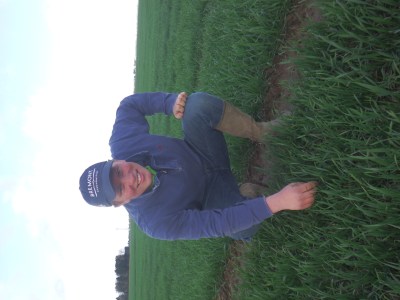
Henry Richardson is aiming for Ascra plus folpet at T1, in recognition of the high septoria risk.
Jonathan agrees that the height of infection won’t be doing the crop any favours. “With no natural leaf separation at the moment, it’s high risk that developing leaves will become infected.”
Tom believes the crop is at least seven to 10 days off a T1 spray.“There’s some variance in growth stages between GS30-31, but a T1 application will be vital in protecting leaf three from disease.”
Although inspection day was rain-free, everyone agrees that they expected the site to have dried up by now. Farm manager Henry Richardson explains the farm has had 80mm of rain since the last visit and two days above 15°C. With this in mind, he’s wary of disease risk and will likely aim for Ascra plus folpet for T1.
He says T2 decisions will again be based on risk. “Univoq is almost a given for Skyscraper and other less resistant varieties. This’ll free up an SDHI like Aviator (bixafen+ prothioconazole) for T3 if needed.”
Boghall Farm, Midlothian
A fresh but dry morning at SRUC’s Boghall Farm concludes this round of the Crop Doctor tour. “It’s a lovely, dewy morning and the crop has really jumped,” says plant pathologist, Professor Fiona Burnett.
“Compared with our visit in March, septoria is more visible, up to leaf four or five. Varietal differences are starting to show depending on crop growth and canopy development.”
Bayer’s Grant Reid concurs. “It’s rocketed – on our last visit the crop was around GS30, if that. It’s now doubled or even trebled in height, with a particularly upright growth habit.”

Temptation to travel when you can, which could be early, means a risk of not hitting the exact application timing, says Fiona Burnett.
As inspections continue, Fiona raises the overall appearance of the crop. “In some plots, the older leaves have shrivelled up and died due to septoria, it’s quite noticeable. Despite newly emerged leaves being clean, inoculum is rubbing against them so it won’t take much for new growth to become infected too.”
She explains that although septoria is successfully ticking over at the site, there’s no sign of other diseases such as yellow or brown rust, or eyespot. But both have seen or heard reports of yellow rust at some commercial farms.
Back to the weather – with a dry week forecast, Grant says growers will be preparing to spray. “It’s important to dissect the crop correctly and make assessments,” he says. “The real risk is being premature with application timings due to an awareness of high disease pressure. That said, field operations are behind – there’s no where near enough spring barley planted at the moment, there are no potatoes in, so there’s an avalanche of work to get through.
“Yes it’s been dry, but the wind speed has meant we’ve had minimal spray days. Temptation to travel when you can, which could be early, means a risk of not hitting the exact application timing.”
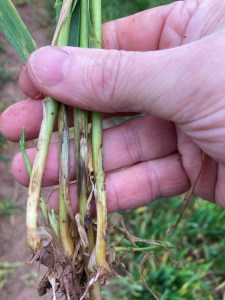
Jonathan Blake says the wet weather has exacerbated eyespot in varieties such as Extase.
Fiona agrees this approach is essentially a waste of money. “Crops are clearly leaping and spray timings may be gappy, but a premature application is wasteful and could be detrimental to yield. I understand it’s hard to wait if you’re presented with a dirty crop such as this year; you’ll be in the mindset of wanting to fix it.”
The team agrees it’ll be all hands to the pump, confirmed by the fact it’s proven tricky to coordinate diaries for the Crop Doctor inspections across all sites this week. According to Grant, it’s spring barley that Scottish growers will be wary of.
“The ground is still very cold, however, seedbeds are good and unlike last year there’s decent soil moisture. Some growers might up their seed rates, but it’s important to not cut back on inputs in this scenario,” he says.
“On the whole, crops are dirtier this year due to the mild autumn, including oilseed rape and winter barley. They’re charging on, so growers will need to keep their eye on the ball and manage their workloads carefully. It’ll be about timely spray applications and an ability to travel,” Grant concludes.
This article was taken from the latest issue of CPM. For more articles like this, subscribe here.
Sign up for Crop Production Magazine’s FREE e-newsletter here.

